Marcum Vs Vexilar (2023 Ice Fishing Flashers Compared)
UPDATED 16 May 2023
by Robert Ceran
This article may contain affiliate links. If you make a purchase after clicking on a link we may earn a small commission at no extra cost to you.
Are you thinking about getting a MarCum or Vexilar flasher, but not sure which one is right for you?
My team and I tested the most popular Marcum and Vexilar ice fishing flashers on the market, and evaluated them on resolution, image quality, ease of use, and overall performance.
Read on below to get the full scoop.
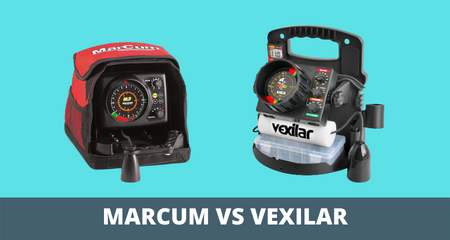
Vexilar vs Marcum flashers (compared side by side)
The table above compares the key specs of the most popular Vexilar and Marcum flashers of comparable price and features that we tested.
Before we discuss each unit in more detail, let’s cover the key similarities and differences of these two lineups a glance:
Target resolution: When comparing Vexilar and Marcum units of similar price and comparable features, you’ll notice that Vexilars generally have higher target resolution than corresponding Marcum units.
For example, the FL-8SE has 1 inch target resolution, while the Marcum M1 has 2 inch target resolution, and the FLX-28 has 0.25 inch resolution, while the Marcum LX7 has 0.5 inch resolution.
Durability: Based on our own testing, as well as on surveying dozens of ice anglers on fishing forums, Vexilar units are more durable than Marcums.
This is due to the simple design and build of Vexilar flashers. Since there are fewer parts that can break or malfunction, when we put them to the test we found that this makes them more reliable in the punishing environment of subzero temperatures and frozen water spray.
For example, during our testing the LCD display of Marcum LX7 units tended to have issues with the screen freezing up, which doesn’t happen with the mechanical fiber optic display of Vex units.
Zoom functionality: Marcum flashers come with a zoom functionality that can be focused anywhere in the water column, which is ideal for targeting not only bottom-hugging fish, but also suspended fish (such as crappie, bluegill, or trout).
Vexilar units, on the other hand, only provide zoom functionality for the bottom part of the water column, and when we tested them we found that they are thus not very helpful for targeting fish that are suspended higher in the water column.
Dual beam transducers: The Marcum M5L and LX7 come with dual beam transducers that can be switched between either an 8 or 20 degree cone angle.
During our testing we found that this is extremely useful when switching between shallow and deep water fishing, since wide sonar angles are better for shallow water, and narrow angles are better for deeper water.
Vexilar transducers don’t have this functionality, which means you need to switch to a different transducer if you want to change from shallow to deep water ice fishing.
Interference reduction: Both brands have effective interference reduction technology, which is important when fishing in proximity to another fisherman on the ice using sonar.
Battery performance: The Marcum M3L and M5L come with a lithium LiFePO4 battery straight out of the box, and when we put it to the test, we found that it has a longer battery life than regular batteries.
In the case of Vexilar, you’ll have to purchase a lithium battery separately, since most units come with regular lead acid batteries.
Noise: During our testing we found that the brushless lighting of Marcum fiber optic displays makes them much quieter than the fiber optic display of Vexilar units.
Pricing: Both brands have broadly similar pricing on comparable units, though you can often get better deals for good units, as well as finding a good used one.
Vexilar FL-8SE
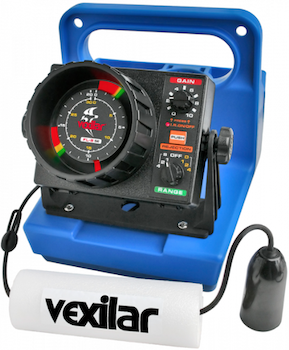

This is Vexilar’s entry level ice fishing flasher, and is a great choice if you’re just getting into ice fishing with flashers.
But don’t be deceived by the affordable price of the FL8. Our testing showed that it’s an excellent all-round flasher that covers all essential functions.
It has a 3-color display that’s color coded to show weak signals in green, medium signals in orange, and strong signals in red.
It comes ready to go out of the box, and provides all essential features you need for catching more fish on ice.
And if you get FL-8 with a Genz Pack (which is highly recommended), this pack includes a battery storage compartment, plus a transducer holder.
The pack also comes with a 12V 9AH battery plus charger, and a 19 degree Ice Ducer transducer.
Retailing at less than $350 dollars, the FL-8SE is our top choice as the best budget ice fishing flasher.
Pros:
- Target ID down to 1 inch
- High-speed real time LED readout
- Affordable
- Three color code for signal intensity – red (strong), orange (medium), green (weak)
- The Genz Pack includes a 12V/9AH battery plus charger, and 19 degree Ice Ducer
Cons:
- 19 degree transducer doesn’t perform well for depths greater than 30 feet
- Noisy
Marcum M1
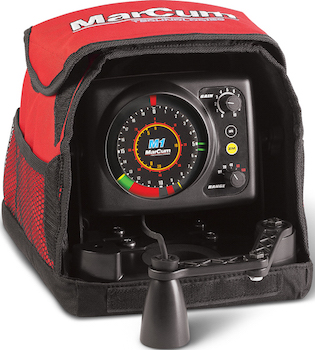

The M1 is the entry level flasher unit of Marcum, but it is capable of doing the majority of the tasks that anybody who is going to go ice fishing would look for in a sonar such as this one.
The Marcum M1 Flasher is one of the most affordable ice fishing flashers currently on the market, and retails at a similar price to the FL-8SE.
However, that does not imply that it is deficient in any way. When we put it to the test, we found that it gives you pretty much everything you need to detect bottom structure and find fish below the ice, and it comes at a price point that is affordable for most anglers.
Pros:
- Noiseless fiber optic display
- Maximum depth up to 160 feet
- Easy to use
- Affordable
Cons:
- Target resolution only 2 inches
- Single cone angle
Vexilar FLX-12
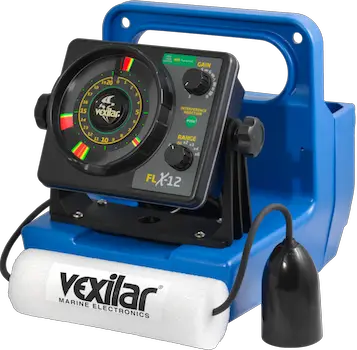

Both beginners and seasoned anglers love the performance and capabilities of the Vexilar FLX-12 ice fishing flasher.
Our testing showed that you can zoom in on the bottom with this three-color flasher without losing sight of the water column, while getting sonar returns in real-time.
With a target resolution of less than half an inch, spotting fish won’t be a problem. This ice fishing flasher also features powerful interference rejection functionality.
The 3-color LED readout, which uses three different colors to indicate if a target is weak, medium, or strong, is what really makes it stand out in my opinion.
Pros:
- High target resolution of up to 1 inch
- 12 degree transducer can be used for both shallow and deeper water
- Extremely durable and reliable
Cons:
- Noisy
- Single cone angle
Vexilar FL-18
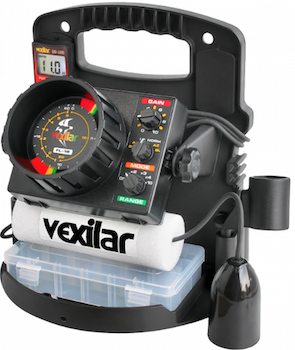

This is Vexilar’s flagship product, and is undoubtedly one of the best ice fishing flashers on the market.
A great feature of the FL18 is its auto zoom function, combined with a split screen functionality that allows you to magnify the region of the water column close to the bottom.
The zoom function allows you to enlarge the signals from the bottom 6 ft. of the water column on one side of the screen, while still viewing the whole water column on the other side of the screen.
When we tested it, we found that this is extremely useful if you’re trying to catch fish close to the bottom (which is most often the case when ice fishing).
The zoom function of the FL18 has a minimum target ID separation of 0.5 inches, which is great for finding walleye and yellow perch sticking close to the bottom.
If you’re in 30 ft. of water or deeper, our testing showed that anything that happens close to the bottom is very hard to visualize in detail on a regular ice fishing flasher, as all the signals are right on top of each other.
So if there are fish moving towards your lure, it will be hard to see them.
However, if you use the zoom function of the Vexilar FL18, our tests revealed that you’ll be able to see your jig and any fish close to it as separate signals, which makes this the best Vexilar model in our opinion.
It also has five different depth scales with a maximum depth of 200 ft., as well as built in interference rejection, and a shallow water setting for ice fishing in less than 15 ft. of water.
Finally, the LED display is color coded to represent different signal intensities. Weak signals are green, medium signals orange, and strong signals red.
With a little practice, this will allow you to estimate fish size, and to tell if a fish is moving from the edge of the sonar cone to its center.
If you get the FL18 as part of the Pro Pack, this includes a 12 V 9 AH battery plus charger, a DD-100 indicator (providing quick depth reading), and a 12 degree Ice Ducer transducer.
With this combination you’re ready to go out of the box.
Pros:
- Target separation of 0.5 inches
- Effective interference rejection
- High-speed real time LED readout
- Shallow water setting for water less than 15 feet
Cons:
- Single cone angle
- Noisy
Marcum M5L
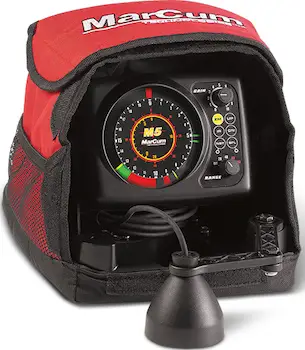

Many anglers feel the MarCum M5L is the best ice fishing sonar on the market.
In addition to having a great target resolution, it operates in total quiet, which is due to the brushless LED lighting.
When we put it to the test, we found that the highly accurate 0.75-inch target separation enables you to identify each fish on the screen, allowing you to know with pinpoint accuracy when a fish is about to inhale your lure.
But during our testing we found that what really sets this flasher apart is the dual-beam transducer, which gives you the ability to switch between 8 and 20-degree cones.
This feature is extremely helpful when you want to switch between shallow and deep water fishing.
The 8 degree cone angle is best for depths over 40 feet, while the 20 degree cone angle is ideal for depths under 40 feet.
Pros:
- Dual cone angles allow you to fish at different depths
- Noiseless LED display
- 0.75 inch target separation
- Zoom feature that can be focused on any part of the water column
- Lithium battery with long life
Cons:
- Heavy
- Lower target resolution than the comparable Vexilar FL-18
See also: Marcum vs Aqua-Vu ice fishing cameras
Vexilar FLX-28


The impressive capabilities offered by the Vexilar FLX-28 make it one of the best ice fishing sonars on the market.
This ice fishing flasher is not only powerful, but also very simple to operate. It is equipped with two zoom zones, and multiple color choices for maximum visibility.
The display of the FLX-28 also comes with a nighttime and daytime brightness level, which not only makes it ideal for ice fishing at night, but testing also revealed that it allows you to read the screen without having to strain your eyes regardless of the amount of available light.
Another unique technology of this Vexilar is its “weed mode,” which allows you to differentiate between weeds and fish.
Finally, it also has a low power option for shallow water that mutes the power of the transducer.
Pros:
- Extremely powerful target resolution of up to 0.25 inches
- Maximum depth up to 300 feet
- Helpful low power mode
- Adjustable brightness of the display makes it easy to read
- Great battery life
Cons:
- Expensive
- Heavy
- Single cone angle
MarCum LX7
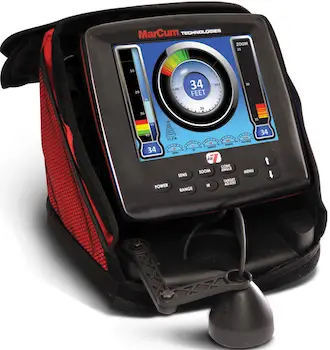

The LX7 is the flagship ice fishing sonar of MarCum, and while it is not actually a flasher but a digital sonar, it provides a truly excellent ice fishing experience.
One of the key features of the LX-7 is that you can choose between a circular flasher display setting (giving a 1D readout of the water column), and a traditional 2D horizontal sonar display setting, which also shows the recent history of what happened in your water column.
In contrast to the Marcum LX5, the LX7 display offers a lot of opportunities to customize the readout settings.
You can decide how to display digital depth, range, gain, battery voltage, interference rejection, and target adjustment.
When we tested it, we found that this is very helpful for fine tuning the settings and keeping an eye on them at all times.
Another of its useful features is the Sonar Footprint technology, which scans an area to find fish targets, either with an 8 degree transducer, or a 20 degree transducer.
Our testing showed that the 20 degree transducer is also great for shallow water ice fishing. Since this sonar cone is wider, it has a chance to open up before it hits the bottom, which makes the MarCum LX7 the best ice fishing sonar for shallow water.
The box includes a 12V 9AH battery plus charger, and comes ready to fish with an ice fishing transducer.
Pros:
- Generous 8-inch LCD display with 800×600 pixels resolution
- Customizable “dashboard” on the display – you can choose the color palette and what information you want to display
- High target resolution up to 0.5 inch
- Dual beam 8/20 degree transducer
- Can choose 5 different ways to display the sonar data: circular flasher, vertical, vertical zoom, graph, graph zoom split screen
Cons:
- Expensive
- Heavy
- Screen has issues with freezing up
Related: What is the difference between a flasher and an ice fishing fish finder?
Final remarks
This concludes our review comparing Marcum vs Vexilar flashers.
The flasher lineups of Vexilar and Marcum include some of the finest ice fishing sonars on the market.
Both lineups provide high end ice fishing flashers and come with near-real time sonar imaging capabilities that make flashers so useful for hard water fishing.
But if you’re thinking about getting either a Vexilar or Marcum flasher, it’s important to understand their differences, as well as their pros and cons.
Hopefully this in-depth comparison will help you find exactly the right ice fishing flasher for your purposes.
Methods and gear used for testing
For consistent testing results we tested all of the ice fishing flashers reviewed in this article over a period of three days on Leech Lake in early February. Ice thickness was 11 to 14 inches, and we tested the flashers by imaging bluegill, crappie, northern pike, and walleye relating to structure in 5 to 23 feet of water.








